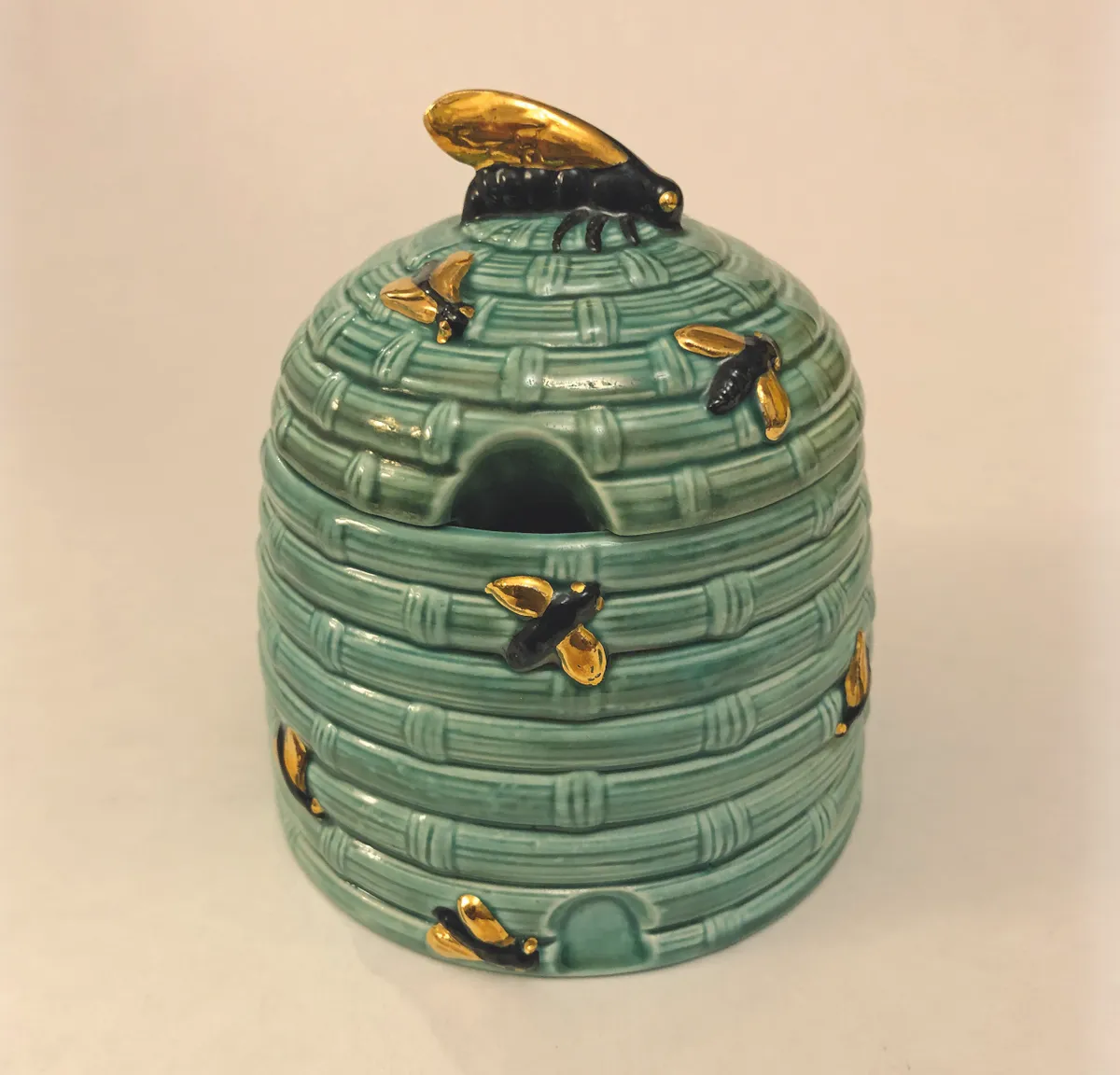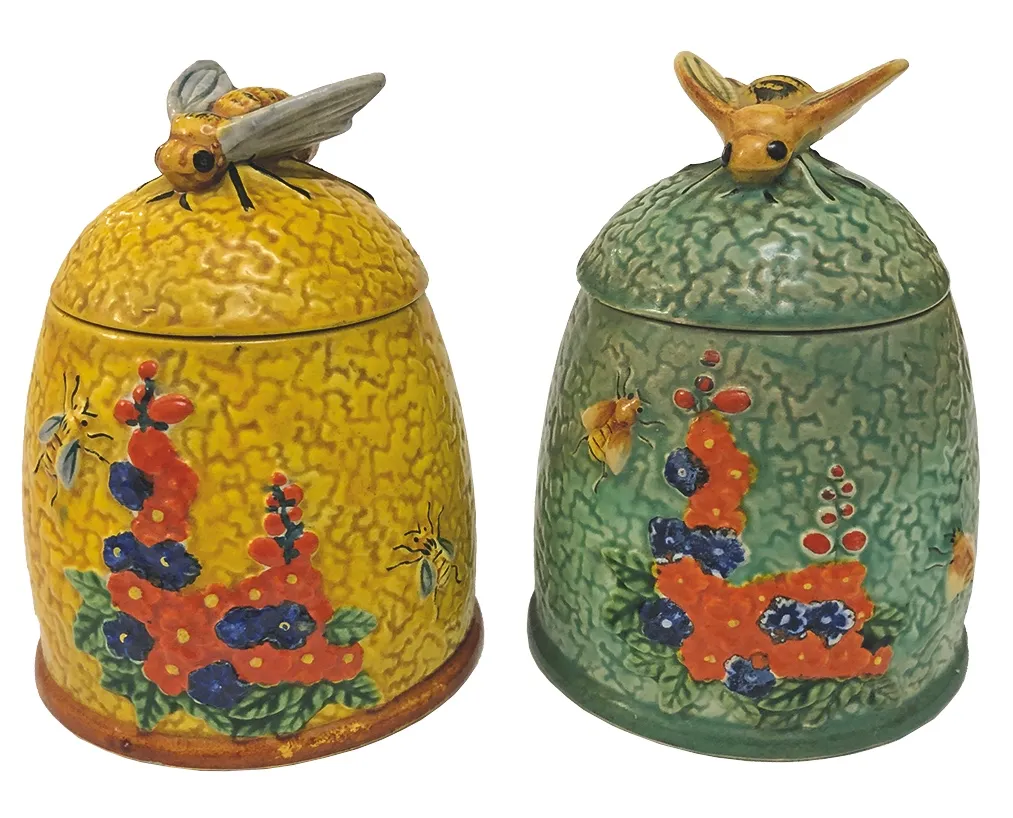James Hamill, Master Beekeeper and Founder of The Hive Honey Shop in London, knows a thing or two about honey pots. ‘My grandfather was a beekeeper and my family has been collecting bee items for 100 years, so I grew up around antique honey pots,’ he explains.
James has amassed a vast bee-related collection that spans coins from 400BC with bees embossed on them, ancient Egyptian mud beehives from the time of the pharaohs and elegant vintage basketwork beehives known as ‘skeps’. But it’s his stash of ‘around 700’ honey pots that captivates him the most.

What are antique honey pots?
Antique honey pots are decorative pots for storing and serving honey. They were made in abundance during the early 20th century, but date back to the Victorian era. Most pots are decorated with bees or honeycomb, or are crafted in the shape of a beehive, and come with a matching spoon for serving the honey.
Antique honey pots come in a range of materials includingceramic, earthenware, stoneware, china, porcelain, acrylic and even wood, silver and pewter (with glass liners).
How much are antique honey pots worth?
Early, rare honey pots occasionally come up at auction and can fetch huge sums. For example, a Staffordshire slipware honey pot c1700 sold for £3,800 in 2019 at Woolley & Wallis. But most of the honey pots on the market date from the early 20th century and are more affordable. ‘There was a huge surge when pottery began to be mass-produced in the early 1900s,’ explains James. ‘The old British makers like Crown Devon, Brunswick, Poole Pottery, Clarice Cliff and Shorter & Son all made beautiful honey pots, and designs by these names are highly sought after. They all had their own patterns and styles and that’s what makes collecting honey pots so exciting.’
An entry-level honey pot can cost as little as £10. ‘That would get you something like a Portuguese Secla honey pot from the 1970s,’ says James. ‘But you can pay £5,000 to £10,000 for older pots in good condition. For example, silver 17th-century honey pots always fetch large sums. In my opinion, bricks and mortar and honey pots are the best investments these days!’
What makes an antique honey pot collectable?
Honey pots are going up in terms of popularity and price. ‘Finding a perfect honey pot gets harder over time,’ explains James. ‘They get broken easily, so if Wedgwood made 5,000 honey pots in 1930, there aren’t many left intact today. Prices go up as more get damaged over time.’ Lots of pots have a bee on the top as the handle, which makes them quite vulnerable. ‘Wings get chipped easily,’ James points out. ‘Also, if somebody doesn’t lift the lid completely, the spoon hits the lid, so you often get chips around the cut-out hole on the interior.’
Collectors are quite particular about what actually constitutes a honey pot: it has to have a bee on it or have a clear connection with bees, such as being in the shape of a beehive. ‘If it’s got fruits on it or is just a general pot that could be used for jam, true connoisseurs aren’t interested,’ says James.
Collector John Doyle founded The European Honey Pot Collectors’ Society, is the author of Collecting Honey Pots, and has 3,000 honey pots in his personal collection, which spans the Victorian era to the 1900s. ‘My favourites are Japanese Marutomoware ones, which date from the 1920s and 1930s,’ he says. ‘They’re cream, bright yellow or green and decorated with beautiful hollyhocks.’

James’s most treasured honey pot is a 1930s one from Buckfast Abbey, the monastery where Brother Adam (who bred a disease-resistant ‘super-bee’ and is credited with saving British bees) lived and worked. ‘It’s a waxed conical container with an embossed picture of the monastery and a monk,’ describes James. ‘They’re impossible to come by. It’s so fragile and full of history. An antiques dealer came into my shop one day and showed me a pristine one with the top still in place. It’s in my glass case of treasured items.’
Where to buy antique honey pots
- The Hive Honey Shop thehivehoneyshop.co.uk
- I. Franksifranks.com
- Hemswell Antique Centres hemswell-antiques.com
- Madelena Antiquesmadelena.com
Where to see antique honey pots
- V&A Museum vam.ac.uk
Words: Ellie Tennant